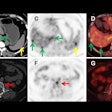
Less than half of the general public sees interventional radiology (IR) as a distinct medical specialty that can improve outcomes for them compared to invasive surgery, according to a recent survey.
A team led by Dr. Mina Makary of Ohio State University in Columbus found that while the public's understanding of the specialty has improved in the past 20 years, there's significant work to be done to raise awareness that IR offers minimally invasive options in many cases over surgery.
"Currently, there is suboptimal awareness of IR within the public, which may contribute to low utilization rates and worsened patient outcomes," the group wrote. "However, there is substantial interest to learn about IR." The study was published online February 8 in the Journal of Vascular Surgery and Interventional Radiology.
IR is a medical specialty that offers minimally invasive image-guided treatment options that often lead to decreased morbidity, mortality, complications, and quicker recovery times compared with surgical operations completed by surgeons, ob/gyns, and urologists, to name a few, the authors wrote.
For instance, uterine fibroid embolizations are a safe and effective alternative to surgical myomectomies or hysterectomies and decrease procedure length, hospital stay, as well as disability periods. However, women undergo hysterectomies for symptomatic fibroids 65 times more than uterine fibroid embolization, the authors explained.
Previous studies suggest that this underuse may be associated with a lack of awareness among both the public and primary-care physicians (PCPs), and that interventional radiologists may not be doing enough to properly educate their patients and the public, the researchers noted.
To obtain a more accurate and reliable assessment of the current rate of IR awareness, the group drew survey responses from a larger, and more broad population than in past research via Amazon's Mechanical Turk crowdsourcing platform.
The researchers received 1,000 anonymous responses. The survey consisted of 69 questions including both Likert-scale and free-text questions that asked about medical and IR-specific knowledge, preferred methods of medical information acquisition, and suggestions for improving IR awareness.
According to an analysis of the responses, 92% of participants preferred undergoing a minimally invasive procedure over surgery, yet only 39.8% recognized IR as a medical specialty.
Among the highlights of the findings are the following:
- Less than half of the general population recognizes interventional radiologists as physicians; of these respondents, less than 40% identified interventional radiology as a unique medical specialty
- Most patients referred to IR for a procedure (n = 113) but yet who ultimately underwent the procedure with a surgeon (n = 66) stated that a lack of IR awareness played a role in their decision
- Almost half of respondents (n = 458) wanted to learn more about IR, with the majority indicating short educational videos and information from their primary care provider would be most beneficial
- Over half of respondents (n = 555) believed the name "Interventional Radiology" to be too ambiguous, with "Minimally-invasive Radiology" the most preferred alternative (21.18%)
The authors noted that this was a follow-up from a survey in 2019 that suggested referring physicians often direct their patients to surgeons rather than interventional radiologists to treat the same pathology -- also because of a poor understanding of IR.
Moving forward, the authors stressed that patient education may be best introduced through primary-care providers with the development of short educational videos outlining the services provided through IR, the authors suggested.
"Optimization of this process has recently garnered support from other societies as the dissemination of online medical information greatly increased during the COVID-19 pandemic. Perhaps the creation of formal guidelines by the [Society of Interventional Radiology] may help facilitate this process," they concluded.



















